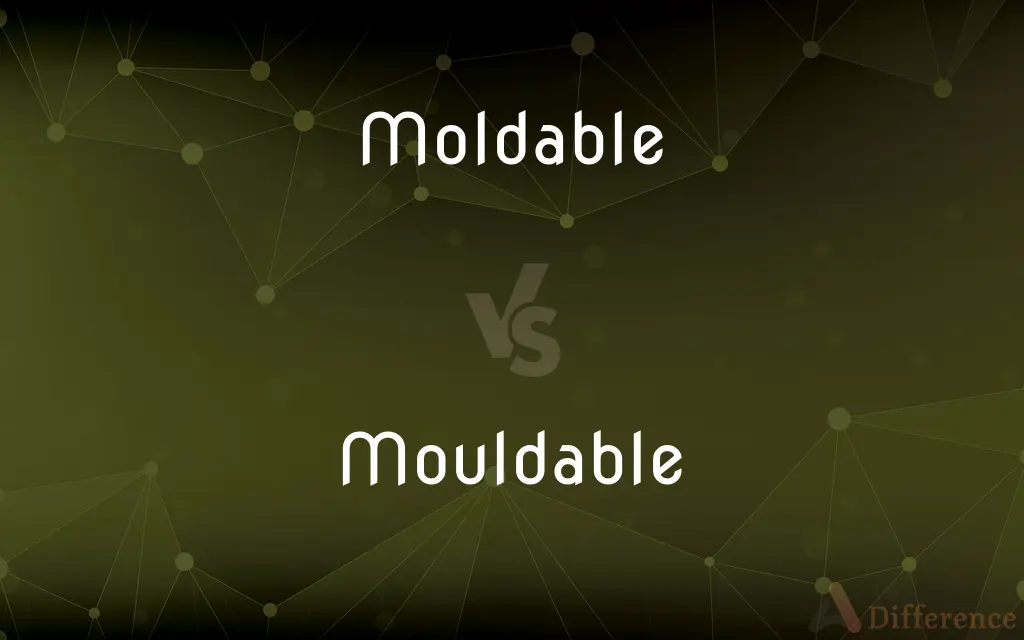Moldable vs. Mouldable — What's the Difference?
By Fiza Rafique & Urooj Arif — Updated on April 7, 2024
Moldable materials can be easily shaped, emphasizing flexibility and adaptability in various applications, while mouldable, the British spelling, shares the same characteristics.

Difference Between Moldable and Mouldable
Table of Contents
ADVERTISEMENT
Key Differences
Moldable materials are characterized by their ability to be shaped and reshaped without breaking, offering versatility in manufacturing and art. Mouldable, simply the British variant in spelling, carries the same implication of flexibility and adaptability in use. This demonstrates how language variations do not alter the inherent properties of the materials described.
Materials that are moldable are often essential in industries where customization is key, such as plastics, clay, and certain metals. Whereas, materials described as mouldable in British English contexts are used in similar industries, highlighting the global nature of material science without the barrier of language differences.
Moldable substances are prized for their capacity to undergo significant deformation without losing their core properties. On the other hand, mouldable substances, notwithstanding the spelling difference, are equally valued for these properties, showing that the terminology does not affect their practical applications.
The choice between "moldable" and "mouldable" often comes down to regional language preferences, with "moldable" being more common in American English. Meanwhile, "mouldable" is predominantly used in British English, reflecting not a difference in material characteristics but in linguistic practices.
Despite the spelling differences, the fundamental qualities that make a material moldable or mouldable are critical in fields such as engineering, art, and design. These qualities include ductility, plasticity, and elasticity, underscoring the universal importance of such materials across various domains.
ADVERTISEMENT
Comparison Chart
Spelling Variance
American English
British English
Usage
Common in the US
Common in the UK and Commonwealth
Industries
Plastics, ceramics, metals
Same as moldable
Key Properties
Ductility, plasticity, elasticity
Identical to moldable
Language Implications
Reflects language preference
Indicates regional linguistic choice
Compare with Definitions
Moldable
Customizable.
The software's moldable features cater to diverse user preferences.
Mouldable
Flexible in use.
Engineers appreciate the mouldable aspects of this composite.
Moldable
Flexible in use.
This moldable plastic adapts to various manufacturing needs.
Mouldable
Capable of being shaped.
The mouldable dough was ready for the baker's hands.
Moldable
Easily influenced.
Young minds are moldable and impressionable.
Mouldable
Easily influenced.
Children’s attitudes are remarkably mouldable.
Moldable
Capable of being shaped.
The artist found the clay highly moldable.
Mouldable
Adaptable to conditions.
The material's mouldable quality facilitates creative design.
Moldable
Adaptable to conditions.
The moldable nature of the material made it perfect for sculptures.
Mouldable
Customizable.
The mouldable settings of the app enhance user experience.
Moldable
A hollow form or matrix for shaping a fluid or plastic substance.
Mouldable
Able to be moulded; plastic
Moldable
A frame or model around or on which something is formed or shaped.
Moldable
Something that is made in or shaped on a mold.
Moldable
The shape or pattern of a mold.
Moldable
General shape or form
The oval mold of her face.
Moldable
Distinctive character or type
A leader in the mold of her predecessors.
Moldable
A fixed or restrictive pattern or form
A method of scientific investigation that broke the mold and led to a new discovery.
Moldable
(Architecture) See molding.
Moldable
To form (something) out of a fluid or plastic material
Molded a cup out of clay.
Moldable
To form into a particular shape; give shape to
Molded the clay into a ball.
Moldable
To guide or determine the growth or development of; influence
A teacher who helps to mold the minds of his students.
Moldable
To fit closely by following the contours of (the body). Used of clothing.
Moldable
To assume a certain shape
Shoes that gradually molded to my feet.
Moldable
(American spelling) mouldable
Moldable
Capable of being molded or formed.
Moldable
Capable of being molded or modeled (especially of earth or clay or other soft material);
Plastic substances such as wax or clay
Common Curiosities
What does moldable mean?
Moldable refers to the ability of a material to be easily shaped or molded without breaking.
Are moldable materials only used in art?
No, moldable materials are used in various fields, including engineering, manufacturing, and design.
Is plastic considered a moldable material?
Yes, plastic is a prime example of a moldable material due to its flexibility and adaptability.
Why is the distinction between moldable and mouldable important?
The distinction is primarily linguistic, reflecting regional spelling preferences without affecting the meaning.
Can any material be considered moldable?
Not all materials are moldable; only those that can be shaped easily without losing their essential properties are considered as such.
Are there any limitations to using moldable materials?
The limitations depend on the specific material's properties, such as its durability, elasticity, and reaction to environmental conditions.
How does temperature affect moldable materials?
Temperature can significantly affect a material's moldability, either enhancing or reducing its ability to be shaped.
What makes a material moldable or mouldable?
A material's ductility, plasticity, and elasticity contribute to its moldability.
What is the difference between moldable and mouldable?
The difference lies in the spelling based on regional language variations, with "moldable" being American English and "mouldable" British English.
Can moldable materials revert to their original shape?
Some moldable materials have memory properties that allow them to revert to their original shape under certain conditions.
Is there a preference for using "moldable" or "mouldable" in scientific contexts?
The preference usually aligns with the regional linguistic practices of the publication or institution.
How are moldable materials beneficial in manufacturing?
They allow for easy customization and adaptation to specific design requirements.
Can moldability affect a material's strength?
Yes, the process of molding can affect a material's strength, depending on how it is manipulated.
Are moldable materials environmentally friendly?
It varies; some moldable materials are biodegradable or recyclable, while others may be less environmentally friendly.
What advancements are being made in moldable material technology?
Advances include the development of new composite materials with enhanced moldability, durability, and environmental friendliness.
Share Your Discovery

Previous Comparison
Feedeth vs. Heedeth
Next Comparison
Require vs. RequiredAuthor Spotlight
Written by
Fiza RafiqueFiza Rafique is a skilled content writer at AskDifference.com, where she meticulously refines and enhances written pieces. Drawing from her vast editorial expertise, Fiza ensures clarity, accuracy, and precision in every article. Passionate about language, she continually seeks to elevate the quality of content for readers worldwide.
Co-written by
Urooj ArifUrooj is a skilled content writer at Ask Difference, known for her exceptional ability to simplify complex topics into engaging and informative content. With a passion for research and a flair for clear, concise writing, she consistently delivers articles that resonate with our diverse audience.















































